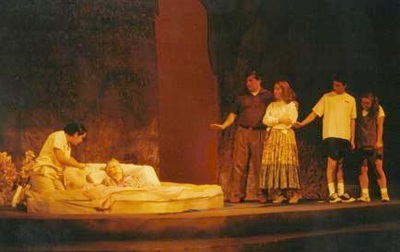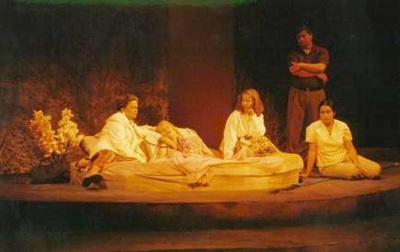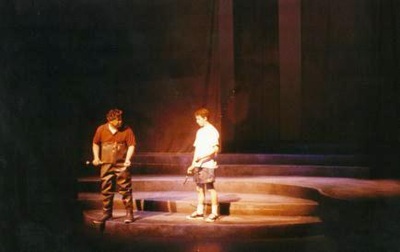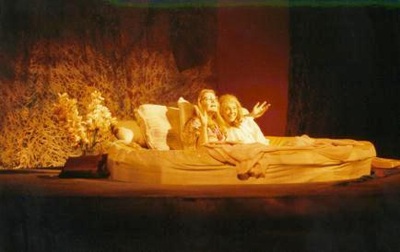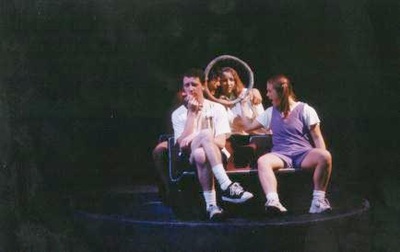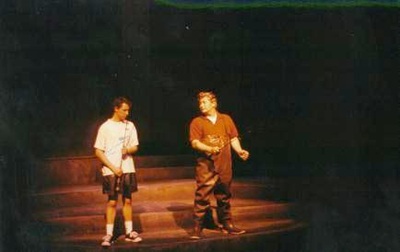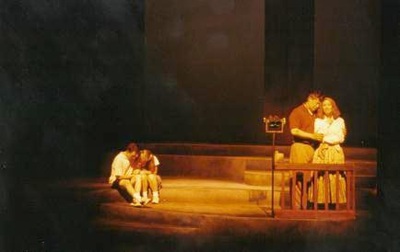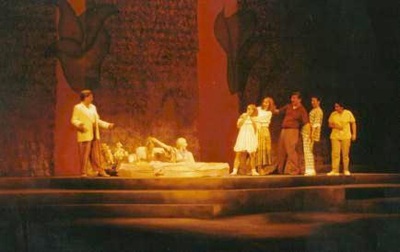A Christmas Carol
Humboldt State University, Arcata CA, October 1998

Director: Patrick Spike
(Master's Thesis Project)
Set by Richard Woods
Lights by Ffaelan
Costumes by Wendy Parks
Sound Design by Patrick Spike
(Master's Thesis Project)
Set by Richard Woods
Lights by Ffaelan
Costumes by Wendy Parks
Sound Design by Patrick Spike
These photos are the property of Patrick Spike, please do not duplicate, download, copy or print without expressed permission. Thank you.
Of Note:
"I hope the audience will come away with a feeling of open possibilities. Discovering the connection, the wonder and the magic in our lives sometimes can be simpler than we imagine."
- Patrick Spike - Director, as quoted in Time Standard article 10/15/98
"[The four main cast members] praised Spike's unique style of directing, which allowed for unlimited potential to come through. They added that Spike felt it was vital that the originality and purity of Howe's dramatic imagination be understood and explored by every cast and crew member. Only then would the audience truly appreciate the truth of the piece."
- as quoted in Time Standard article 10/15/98
Voted - Outstanding Sound design/effects (Patrick Spike)
- by Beti Trauth, "Beti's Best" - Humboldt Beacon
Concept Statement, Approaching Zanzibar
Introduction
For my thesis production, I had originally submitted Christopher Marlowe’s Edward II as my first choice. I had an ambitious concept for the production including a script adaptation to be done by me. I had been directing productions literally non-stop since before I began my graduate work. When I began work on the adaptation, I realized the scope of the project, and that I might not have the energy at that time for the added work that this particular concept was going to require of me. Additionally, off-campus actors that I was counting on for the cast of 35 suddenly were becoming less available. Then HSU’s theatre department decided to produce Angels in America, Parts 1 & 2 in the same semester. I realized that this was not the time to do this production. I spoke to my advisor and we decided to pursue a different script. I then proposed Approaching Zanzibar, a script I had wanted to direct for some time, and it was accepted by my graduate committee. This was a script that would be simpler to cast as well as costume. With its unique ‘Tina Howe’ style -- magical, comedic, sincere and human -- it still offered unique challenges and added a new genre to the package of shows I’ve directed at HSU.
Concept & Goals - (as distributed to the design team at our first production meeting)
Themes Presented
"The play is about, among other abstract nouns,
death and love and birth, and in a sense, rebirth." - Tina Howe
1) Death and mortality / life and living - fear of the unknown
2) Our different roles through the cycles of life:
- Past role models and norms need to be redefined and expanded. Charlotte and Wally illustrate the feelings of being lost - the roles they were taught are no longer appropriate.
- Charlotte fears losing her sense of self-definition as she loses her ability to bear children and as her children begin to define themselves and become more independent.
3) Presentation of a new model of family love - perhaps a new definition of family.
4) Facing the questions of existence: what is our place in the world?
5) We all leave a legacy behind us - children, art, a presence in the world that ripples out from us. What is our responsibility to that legacy?
Design Elements
Overall: This is a very gentle play with an undulation that moves among fear, comic situations, magical and transcendent moments of wonder. We need not work to recreate reality on stage, but rather suggest the settings and locations through the magical vision of Olivia.
Set: I like the author’s recommendation to use fabric in the design of the set as it is Olivia’s medium and thematically brings closure to the characters journey’s and supports the prophetic qualities of Olivia. The show needs to move very smoothly from scene to scene, preferably without the actors leaving the stage. Perhaps all the scenic elements can come out of the fabric (ie: the tents simply pop up from fabric on the floor with poles, the sail of the boat rises up on a line dropped in from the fly system, the bed rises up from the floor under fabric…) so that all props, costume pieces, and set items are hidden within the fabric out of view. The vistas, night sky and stars all need to have magical and borderline surreal qualities to capture Howe’s style of walking the line between realism and surrealism.
Lights: Lights, while providing smooth transitions between scenes and establishing the locales in an abstract stage setting, must also support the pseudo-surreal and magical style. Beautiful effects can be explored for the rainstorm, the starlit sky, sunsets, mornings, etc.
Costume: While the costumes will most likely be relied upon to lift the actors off the backgrounds, it might also be interesting to explore how they are also a part of this vision, of this magical dream. Costumes for the family are tricky due to the fact that they will seldom leave stage. How to create a pajama look without time for a real costume change?
Sound: Sound is an integral part of this production, playing into Charlotte’s desire to hear the crying baby, the magical humming of the spheres, etc. Sound will be a great help in establishing local and environment.
Makeup/Hair: A fairly basic defining/corrective makeup overall, with the one exception being Olivia who will be made to look ill with the gray and bald wigs.
Concept Metaphor (as created in collaboration with the design team)
This production of Tina Howe’s Approaching Zanzibar and the design elements therein will be as a lone flower, gently opening, blossoming in a forest, attempting to reveal its center. The mist is moving by, swirling between the trees and around the petals of the flower as the sun is rising, dissipating the mist and beginning to make clear our vision.
Challenges and Approach
In choosing this script, the biggest gamble was to be the space. Edward II had already been slated for the John Van Duzer mainstage at HSU, a 750 seat house with balcony, orchestra pit, and full fly system. This is a rather intimate script in its character interactions and its small, often enclosed scenes. However, the journeys of the family, both in their voyage across country as well as their internal journeys, are expansive. I knew the intimacy of the scenes would be a challenge to accomplish, but felt the expanse of the stage would afford us some very interesting means of performing transitions, demonstrating the road trip, and representing the locales.
The many locations at which the family stops along their trip has to be represented somehow, even if only in the abstract. Given the space we had to work with, I utilized different areas of the stage for each location. In keeping with our opening flower metaphor the set was designed to open, unfold out of the floor to establish each scene. The family moved from one location to the next through transition.
Another element inherent in this play is the wide age range of the characters. The youngest child is approximately 9 years old, and the dying Aunt Olivia is in her 80’s. Conceptually, however, I see the ways in which the family comes to understand each other as key to their development and journey, as is finally represented in the character reversal scene in the car. Therefore, I decided I wanted to cast the parents and children as near the same age, between the ages of the parents and the children. In doing this I hoped to make specific comment on how the children and parents behave differently, yet their roles in the world are shifting, they are unsure.
Outcome
Upon completion of this production, I was very happy with my direction of the production, including my overall vision, work with the actors, and guidance of the design elements. The characters and their arcs were complete and clear. The themes of the show were communicated as I intended and the relationships and scene structures were solid. These elements were highly successful and audiences greatly enjoyed the production.
If I have any regrets, it is that I didn’t ask for a complete model of the set from my designer. What I had understood would be elements that smoothly, rhythmically unfolded from the floor, graceful appearing and disappearing, ended up being somewhat clumsy, complicated, and hesitant. The designer assigned different students in the scene shop to create each element. This meant I did not see many of these pieces until our technical rehearsal. At this point in the process it was really too late to alter the designs to make them more graceful or even to make them more harmonious with the overall design. I understood his desire to boost students' experiences and learning, but I feel the overall production suffered. Scene changes/transitions were lengthy, cumbersome, and not how I had intended.
Additionally, the challenges inherent in using such a large theater space became problematic. The intimacy of some moments, particularly in the final scene in Olivia’s bedroom, was somewhat sacrificed. Although the history of theatre recalls the larger houses of the past, today we do indeed enjoy the intimacy granted in our smaller theaters. These very quiet intimate moments could have been better realized in a smaller house. It was a trade-off for the expansive feel of our stage and set.
"I hope the audience will come away with a feeling of open possibilities. Discovering the connection, the wonder and the magic in our lives sometimes can be simpler than we imagine."
- Patrick Spike - Director, as quoted in Time Standard article 10/15/98
"[The four main cast members] praised Spike's unique style of directing, which allowed for unlimited potential to come through. They added that Spike felt it was vital that the originality and purity of Howe's dramatic imagination be understood and explored by every cast and crew member. Only then would the audience truly appreciate the truth of the piece."
- as quoted in Time Standard article 10/15/98
Voted - Outstanding Sound design/effects (Patrick Spike)
- by Beti Trauth, "Beti's Best" - Humboldt Beacon
Concept Statement, Approaching Zanzibar
Introduction
For my thesis production, I had originally submitted Christopher Marlowe’s Edward II as my first choice. I had an ambitious concept for the production including a script adaptation to be done by me. I had been directing productions literally non-stop since before I began my graduate work. When I began work on the adaptation, I realized the scope of the project, and that I might not have the energy at that time for the added work that this particular concept was going to require of me. Additionally, off-campus actors that I was counting on for the cast of 35 suddenly were becoming less available. Then HSU’s theatre department decided to produce Angels in America, Parts 1 & 2 in the same semester. I realized that this was not the time to do this production. I spoke to my advisor and we decided to pursue a different script. I then proposed Approaching Zanzibar, a script I had wanted to direct for some time, and it was accepted by my graduate committee. This was a script that would be simpler to cast as well as costume. With its unique ‘Tina Howe’ style -- magical, comedic, sincere and human -- it still offered unique challenges and added a new genre to the package of shows I’ve directed at HSU.
Concept & Goals - (as distributed to the design team at our first production meeting)
Themes Presented
"The play is about, among other abstract nouns,
death and love and birth, and in a sense, rebirth." - Tina Howe
1) Death and mortality / life and living - fear of the unknown
2) Our different roles through the cycles of life:
- Past role models and norms need to be redefined and expanded. Charlotte and Wally illustrate the feelings of being lost - the roles they were taught are no longer appropriate.
- Charlotte fears losing her sense of self-definition as she loses her ability to bear children and as her children begin to define themselves and become more independent.
3) Presentation of a new model of family love - perhaps a new definition of family.
4) Facing the questions of existence: what is our place in the world?
5) We all leave a legacy behind us - children, art, a presence in the world that ripples out from us. What is our responsibility to that legacy?
Design Elements
Overall: This is a very gentle play with an undulation that moves among fear, comic situations, magical and transcendent moments of wonder. We need not work to recreate reality on stage, but rather suggest the settings and locations through the magical vision of Olivia.
Set: I like the author’s recommendation to use fabric in the design of the set as it is Olivia’s medium and thematically brings closure to the characters journey’s and supports the prophetic qualities of Olivia. The show needs to move very smoothly from scene to scene, preferably without the actors leaving the stage. Perhaps all the scenic elements can come out of the fabric (ie: the tents simply pop up from fabric on the floor with poles, the sail of the boat rises up on a line dropped in from the fly system, the bed rises up from the floor under fabric…) so that all props, costume pieces, and set items are hidden within the fabric out of view. The vistas, night sky and stars all need to have magical and borderline surreal qualities to capture Howe’s style of walking the line between realism and surrealism.
Lights: Lights, while providing smooth transitions between scenes and establishing the locales in an abstract stage setting, must also support the pseudo-surreal and magical style. Beautiful effects can be explored for the rainstorm, the starlit sky, sunsets, mornings, etc.
Costume: While the costumes will most likely be relied upon to lift the actors off the backgrounds, it might also be interesting to explore how they are also a part of this vision, of this magical dream. Costumes for the family are tricky due to the fact that they will seldom leave stage. How to create a pajama look without time for a real costume change?
Sound: Sound is an integral part of this production, playing into Charlotte’s desire to hear the crying baby, the magical humming of the spheres, etc. Sound will be a great help in establishing local and environment.
Makeup/Hair: A fairly basic defining/corrective makeup overall, with the one exception being Olivia who will be made to look ill with the gray and bald wigs.
Concept Metaphor (as created in collaboration with the design team)
This production of Tina Howe’s Approaching Zanzibar and the design elements therein will be as a lone flower, gently opening, blossoming in a forest, attempting to reveal its center. The mist is moving by, swirling between the trees and around the petals of the flower as the sun is rising, dissipating the mist and beginning to make clear our vision.
Challenges and Approach
In choosing this script, the biggest gamble was to be the space. Edward II had already been slated for the John Van Duzer mainstage at HSU, a 750 seat house with balcony, orchestra pit, and full fly system. This is a rather intimate script in its character interactions and its small, often enclosed scenes. However, the journeys of the family, both in their voyage across country as well as their internal journeys, are expansive. I knew the intimacy of the scenes would be a challenge to accomplish, but felt the expanse of the stage would afford us some very interesting means of performing transitions, demonstrating the road trip, and representing the locales.
The many locations at which the family stops along their trip has to be represented somehow, even if only in the abstract. Given the space we had to work with, I utilized different areas of the stage for each location. In keeping with our opening flower metaphor the set was designed to open, unfold out of the floor to establish each scene. The family moved from one location to the next through transition.
Another element inherent in this play is the wide age range of the characters. The youngest child is approximately 9 years old, and the dying Aunt Olivia is in her 80’s. Conceptually, however, I see the ways in which the family comes to understand each other as key to their development and journey, as is finally represented in the character reversal scene in the car. Therefore, I decided I wanted to cast the parents and children as near the same age, between the ages of the parents and the children. In doing this I hoped to make specific comment on how the children and parents behave differently, yet their roles in the world are shifting, they are unsure.
Outcome
Upon completion of this production, I was very happy with my direction of the production, including my overall vision, work with the actors, and guidance of the design elements. The characters and their arcs were complete and clear. The themes of the show were communicated as I intended and the relationships and scene structures were solid. These elements were highly successful and audiences greatly enjoyed the production.
If I have any regrets, it is that I didn’t ask for a complete model of the set from my designer. What I had understood would be elements that smoothly, rhythmically unfolded from the floor, graceful appearing and disappearing, ended up being somewhat clumsy, complicated, and hesitant. The designer assigned different students in the scene shop to create each element. This meant I did not see many of these pieces until our technical rehearsal. At this point in the process it was really too late to alter the designs to make them more graceful or even to make them more harmonious with the overall design. I understood his desire to boost students' experiences and learning, but I feel the overall production suffered. Scene changes/transitions were lengthy, cumbersome, and not how I had intended.
Additionally, the challenges inherent in using such a large theater space became problematic. The intimacy of some moments, particularly in the final scene in Olivia’s bedroom, was somewhat sacrificed. Although the history of theatre recalls the larger houses of the past, today we do indeed enjoy the intimacy granted in our smaller theaters. These very quiet intimate moments could have been better realized in a smaller house. It was a trade-off for the expansive feel of our stage and set.




